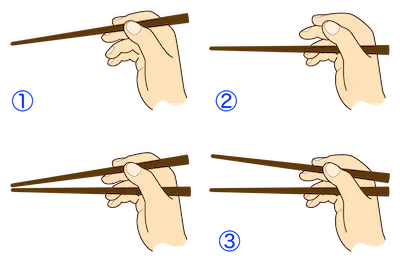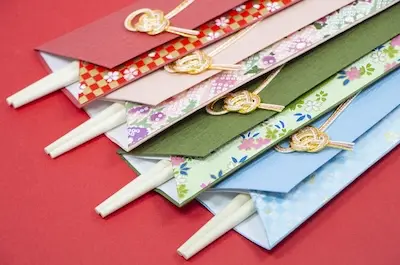
Japanese Chopstick Etiquette: Proper Use and Table Rules
Why Proper Chopstick Use Matters
In Japan, children learn how to hold and use chopsticks correctly from a young age.
Lately, more foreign visitors are seen using chopsticks when dining here.
Learning the right way to hold and use chopsticks is important.
It helps you eat neatly and shows good manners.
How to Hold and Use Chopsticks Correctly
Here, we explain the basic way to hold and use chopsticks.
Basic Chopstick Holding
① Hold the top chopstick like a pencil, using your thumb, middle finger, and ring finger.
② Fix the bottom chopstick between the base of your thumb and the side of your ring finger’s nail.
③ Move only the top chopstick while keeping the bottom one still.
The key point is to move only the top chopstick, not both like scissors.
Tips and Advice
- People with large hands should use longer chopsticks. Those with small hands should use shorter ones.
- When practicing, start with soft, less slippery foods like rice or simmered dishes instead of hard foods like beans or carrots.
- Be careful not to hold the chopsticks too close to the tips or too close to the base, as it can look unnatural.
Chopstick Taboos to Avoid in Japan
In Japan, there are several chopstick taboos to be aware of.These actions can leave a bad impression during meals.
Some of them also relate to customs found in Buddhist funerals.
In addition, how you use chopsticks is sometimes seen as a reflection of your upbringing and awareness of others.
That’s why using chopsticks with care is considered important in Japan.
7 Key Things to Watch Out For
1. Sashi-bashi (Pointing with chopsticks)
Pointing at people or things with chopsticks is rude.
Avoid using them as a gesture while talking.
2. Tate-bashi (Sticking chopsticks upright in rice)
Sticking them upright in rice is seen as bad luck.
It resembles a funeral ritual.
3. Watashi-bashi (Resting chopsticks across a bowl)
Resting them across a bowl suggests you’re done eating.
Use a chopstick rest instead.
4. Saguri-bashi (Digging through food)
Don’t dig around to pick favorite items.
It’s impolite, especially when sharing food.
5. Yose-bashi (Pulling dishes toward you with chopsticks)
Don’t drag dishes toward you with chopsticks.
Use your hands instead.
6. Mayoi-bashi (Hovering chopsticks over food)
Hovering while deciding what to eat looks indecisive.
It leaves a bad impression.
7. Jika-bashi (Using your own chopsticks to serve food)
Don’t serve from shared plates with your own chopsticks.
Use serving chopsticks or the opposite ends.
3 Quick Chopstick Tips
1. Use a chopstick rest hen available
Never place chopsticks directly on the table.
Always use a chopstick rest if one is provided.
2. Don’t rub disposable chopsticks together
You might want to remove splinters, but rubbing chopsticks can be seen as rude in Japan.
3. It’s okay to follow others
You don’t need to be perfect from the start.
Watch how people around you use chopsticks and learn as you go.
Proper Way to Hold Your Bowl
In Japan, it is customary to hold your rice bowl or soup bowl during meals.
Here are key points to remember:
- Hold the bowl with the hand opposite your chopsticks.
→ If you use your right hand for chopsticks, hold the bowl with your left hand. - Eating without holding the bowl may be seen as a breach of dining etiquette.
- For extra politeness, lift the bowl with both hands, then switch to holding it with one hand.
Paying attention to how you hold your bowl is part of Japanese dining etiquette.
Before and after meals, certain phrases are important in Japanese culture. Learn more about these expressions to enhance your dining experience.
・“Itadakimasu”: The Meaning and Etiquette Before Meals
・“Gochisosama”: How to Properly Say Thanks After Eating
Japanese of the Day / 今日の日本語
- Japanese of the Day / 今日の日本語
- Word:箸 (はし / hashi) – chopsticks
- Meaning:A pair of sticks used in Japan (and other Asian countries) to eat food.
They are not only utensils but also carry cultural etiquette. - Example:日本では、箸を正しく使うことが大切です。(Nihon de wa, hashi o tadashiku tsukau koto ga taisetsu desu.)
(In Japan, it is important to use chopsticks properly.) - Fun Fact:Japanese chopsticks are usually shorter than Chinese or Korean ones.
Certain actions, like sticking chopsticks upright in rice, are considered bad manners because they resemble funeral rituals.
◆ Would you like to practice speaking Japanese? ◆
In my lessons, you can use Japanese a lot and learn to speak naturally with me.
箸の正しい使い方が大切な理由
日本では、子供の頃から家庭で箸の正しい持ち方と使い方を習います。
最近では外国人の方でも箸を使っている方をお見かけすることが増えてきました。
正しい箸の持ち方や使い方を身につけることは大切です。きれいに食事できるだけでなく、マナーの良さも伝わります。
箸の正しい持ち方・使い方
ここでは、基本的な持ち方と使い方を紹介します。
箸の持ち方(基本)
① 上の箸を鉛筆を持つように、親指、中指、薬指で持ちます。
② 下の箸は、親指の付け根と薬指の爪の横で固定します。
③ 上の箸だけを動かして、下の箸は固定したまま使います。
このように、上下の箸を「はさみ」のように動かすのではなく、上の箸だけを動かすのがポイントです。
コツと注意点
- 手が大きい方は長い箸を、手が小さい方は短い箸をつかいましょう。
- 最初は硬い食べ物(豆やにんじん)よりも、柔らかくて滑りにくいもの(ご飯や煮物)から練習するとよいでしょう。
- 箸を持つ位置があまりにも先(食べ物側)や根元に近すぎると、不自然に見えるので注意が必要です。
やってはいけない7つの箸マナー
日本では「箸のタブー」と呼ばれるマナー違反がいくつかあります。これらは、食事中に不快な印象を与えるだけでなく、仏教の葬儀に関係する行為と重なることもあります。
また、箸の使い方はその人の「育ち」や「気配り」を表すと考えられることもありす。そのため、丁寧に扱うことが望ましいとされます。
特に気をつけてほしい代表的な7つ
1. 指し箸(さしばし)
箸で人や物を指すこと。
これは失礼にあたります。会話中でも、ジェスチャーとして箸で指すのは控えましょう。
2. 立て箸(たてばし)
ご飯の上に箸を垂直に立てる行為。
これは、葬儀の際に故人への供え物として行う作法で、不吉な行為とされています。
3. 渡し箸(わたしばし)
食事の途中で、箸を器の上に渡すように置くこと。
「もう食べません」という印象を与えるため、食事中は避けた方が良いとされます。
4. 探り箸(さぐりばし)
料理の中を箸でかきまぜたり、好みの具材を探したりする行為。
他の人とシェアする料理では、特に嫌がられます。
5. 寄せ箸(よせばし)
箸で器やお皿を引き寄せる行為。
本来、器は手で持つものとされており、箸で動かすのはマナー違反です。
6. 迷い箸(まよいばし)
どの料理を食べようかと、料理の上で箸をあちこち動かす行為。
行儀が悪いという印象を与えてしまいます。
7. 直箸(じかばし)
大皿から料理を取るときに、自分が食べていた箸をそのまま使う行為。
取り箸がある場合は、それを使いましょう。
箸マナー3つのヒント
1.箸置きがあるときは必ず使う
→ 箸を直接テーブルに置かないようにしましょう。
2. 割り箸はこすらない
→ 木くずが気になるかもしれませんが、日本では「失礼」と思われることもあります。
3.まわりを見てまねするのもOK
→ 初めてのときは、無理に完璧を目指す必要はありません。
周囲の人の使い方を見ながら、少しずつ慣れていきましょう。
器の持ち方にも気をつけよう
日本では、食事中にお茶碗(ごはん)やお椀(みそ汁など)を手に持つのが基本とされています。
このときのポイントは以下の通りです:
- お茶碗やお椀は、箸を持つ手とは反対の手で持ちましょう。
→ 右手で箸を持つ人は、左手で器を持ちます。 - 器を持たずにテーブルに置いたまま食べると、「行儀が悪い」と思われることもあります。
- 両手で器を持ち上げてから、片手に持ち替えると丁寧です。
このような器の持ち方もマナーのひとつとして見られるため、日本料理を食べるときに意識してみると良いでしょう。
日本の食事では、始まりと終わりの挨拶も大切です。
さらにマナーを深めるために、こちらの記事もご覧ください。
・「いただきます」の意味とマナー
・「ごちそうさま」の使い方と礼儀



